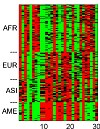
Fancy a new vase or some unbreakable crockery for that camping trip, but haven’t got time to go shopping? What about a replacement for the broken spoke on your spectacles or an individually designed heads for your golf clubs? Or, how about a scale model of that new sports car your kids designed or a mini objet d’art created from photos of a Henry Moore sculpture? The possibilities for 3D printing are limited only by your imagination and what someone could come up with in a 3D drawing package or with CAD software.
3D printing, rapid prototyping, as it is often known, is not new. I first heard about 3D printing sometime in late 1980s while still a student. However, these devices, which have featured in TV shows such as CSI, could soon be coming to a workshop near you and may represent the biggest shift in commerce and manufacturing in decades. The Fab@Home wiki has more information on the technology, but 3D printing, essentially, turns a digitized representation of a solid object, which you might download, email, or create, into a real solid object. It using a vat of uncooked starting material (plastic, metal or alloy) and a laser, or other device, controlled by computer holding the digitized information to build up the object layer by layer.
There are numerous commercial 3D printers, known in some circles as fabbers, being used by the military for creating battle components in the field, in design studios for prototyping, and more recently for creating just about anything you care to name. However, once the killer app emerges, these machines will quickly enter the mainstream.
There are several videos of 3D printers in action on Youtube. But, I was brainstorming with my wife today, while walking the dog, to see if we could think of that killer app…clothes, disposable diapers or nappies, plastic paperclips, teacups, and buckets, were my first few suggestions. But, I blush to tell you what her first suggestion was…sex toys. Moreover, it’s our silicon wedding anniversary today, and all I could think was that she was trying to tell me something.
But, then it occurred to me, how 3D printing might rapidly move into the mainstream, and no, I’m not thinking of rubbery objects for the bedroom, but virtual gifts!
With the advent of social networking and web 2.0 communities there are often occasions when you might wish to reward or surprise someone you meet or interact with in such virtual spaces. Being sent a link to an interesting site, image, or music file as a gift is nice. But, what if you could send someone a solid object without actually having to buy it, package it up (discretely in some cases), and ship it out? A 3D printer suddenly becomes a way to spread the lurv in polymer resin. And, if you’re getting really close to that certain someone you met online, then you could always take on my wife’s original idea, and spread more than a little lurv, although I don’t a 3D printer exists yet that can produce 1.5 volt batteries.
What will you make with your 3D printer?
 Plain or Vanilla
Plain or Vanilla




